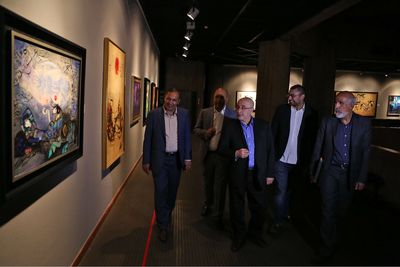Nasser Ovissi’s work is showing at the Museum of Contemporary Art in Tehran for a limited period of time. It’s the must-see exhibition this week.
The long-anticipated event was inaugurated Saturday with a group of outstanding artists in attendance, including Hossein Mahjoubi, Kourosh Shishegaran, Javad Mojabi, Mozhdeh Tabatabaei, Mohammad Rahmanian, Mahboubeh Kazemi, Sohrab Hadi, and Mohammad Hadi Fadavi.
Nasser Oveissi is an Iranian-born artist who currently resides in the US. He is a well-renowned artist whose work hangs on walls across the world, and had had many books published on his work. He is one of Iran’s most renowned and successful living contemporary artists.
Addressing the opening ceremony, museum curator Ali Mohammad Zare-Parast said, “The plan was to hold the exhibition for at least two months, but for some restrictions we had to limit it. As requested by the Art Center managers, the exhibition is held concurrently with the Ganjineh exhibition in order to familiarize visitors with the history of Iranian art.”
Also speaking, Art Center curator Vahid Malek said, “Ovissi is not among us. But today marks the 60th anniversary of his work. Many world capitals have handed their golden keys to him. He has won prestigious awards and held exhibitions along with masters such as Salvador Dali and Marc Chagall. After more than half a century, Ovissi’s art is still on display across the globe along with other contemporary artists. We are delighted to see this happening. Of course, he deserves better.”
Also speaking, writer, poet and researcher Javad Mojabi said, “Ovissi’s art has been on display for 60 years now. At just 23, he won award for an impressionist painting. He contemporized Persian miniature - a small painting on paper, whether a book illustration or a separate work of art intended to be kept in an album – which later became his signature.”
He added, “Ovissi viewed Persian miniature as Iranian heritage. He simplified the lines and the coloring and instantly transformed the traditional trend of Iranian painting into modern art. He was inspired by the late and early 19th century Persian art, but also paid attention to modern art. The empty spaces on his work come from the simple lines and drawings that exist in Chinese and Japanese work. When he decided to live in Europe and the United State, he also got influenced by modern art in the West.
In conclusion he said, “Ovissi’s zest for life has beatified his work. He always dreams of living in a simple world with free people. Wherever he goes, he carries with him the love of his country, its art, culture and history.”
At the end of the ceremony, the organizers unveiled a book published on his work.

